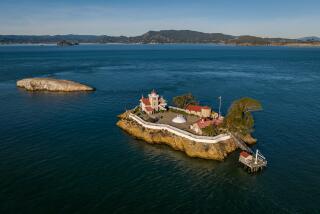A Rugged Repose
- Share via
MONHEGAN ISLAND, Maine — There is a painting by Jamie Wyeth that moves me with its tranquillity: a pensive woman in a room that looks out at the sea. He calls it “If Once You Have Slept on an Island.”
I have slept on Monhegan Island, 10 miles off the coast of Maine. During the night, fog horns sound, wind tosses the tall spruces, rain pelts the window. I snuggle under the covers, keeping the Maine chill at bay.
I have also awakened on Monhegan. Dawn arrives crystalline, sky blue, sunrise orange. The bracing air calls me out of my room into the summer day.
It helps, too, that there are few amenities to keep me indoors. On this island, electricity is high technology, available only to a few places where people have generators. The rest of us make do with kerosene lanterns and wood stoves.
People have been summering on Monhegan for a century, drawn by its mix of hardship, challenge, beauty and serenity. I am here for a photography workshop with a group from my hometown, and I anticipate a few days of rest and more than a few moments of exhilaration.
Dark headlands, the highest on the New England coast, plunge to the swirling sea and rocks. I back away from the cliff’s edge, my knees mushy as I think of my children back home. People drown here; the tides and undertow are ferocious. A tourist information leaflet warns that “trails are rough and wild; tidal currents and undertow make rescue impossible.” It also advises visitors to wear sturdy shoes--this is no place for strapless sandals.
Clambering over rocks to the water’s edge is a given. There’s no soft white sand here, no place for a beach towel. When I step into the water, my feet go numb. The wind blows hard, sending my hat aloft, my hair swirling across my face.
This is not a gentle place, but it is a place of unsurpassed beauty and calm. It cancels out time, sometimes creating a peace so profound I fall asleep on a hard bench, no pillow under my head, only sun and breezes touching my skin.
At 4 o’clock one morning a friend pounds on my door in the Trailing Yew Inn. We are supposed to photograph the sunrise. I groan, look at the clock, put the pillow over my head. But then I struggle into my jeans and trek blindly over the rocky trail behind him, half a
mile to the east side of the island. (Monhegan is half a mile wide and only three times as long.) Ahead of us is the sun, a glowing beach ball pushing up from the horizon, lighting the rocks, water and ocean spray with gold. The visual beauty, the sound of the surf on the rocks and the gentle warmth of the dawn sun on my face make me grateful for the knock on the door.
Another morning I meet the dawn from the west coast of the island, where the village and harbor lie. Lobster boats glint in the early light, looking ready for a day’s work. The sea sparkles. So do rooftops shedding morning dew.
Not far from the water, a lobsterman in bright yellow oilskins sits in his orange boat, paddling his oars at the speed of the wind, sometimes slowly, sometimes fast. He is of course not real, just a windmill lawn decoration rowing furiously among the buoys, traps and ropes that litter the harbor front.
Another morning, the air is drenched with fog, turning Monhegan monochromatic, moody, mysterious. People and things float in and out of the mist, hard edges blurred.
As I pick my way over the rough trails to the cliffs, the mist is cool on my face, the pounding surf more frightening because I can’t see it. Invisible gulls scream overhead; buildings disappear. The world is impenetrable. Monhegan hides.
People who come here to capture the island on paper and canvas joke about a new color for the Crayola box: Monhegan gray.
But amid the gray, splashes of color emerge, appearing strangely bright, almost iridescent in the mist. A hike to Christmas Cove reveals a colorful world of seaweed, red pebbles, starfish and snails in the tide pools. Pebble Beach is a gray, boulder-strewn moonscape, but on the water, a white sailboat glows against the deep blue of the sea. Cathedral Woods, spooky in the fog, invites a closer look; the ground beneath the black spruces is dotted with colorful lichens and mushrooms, haunted by fairies. On a trail far inland I stumble upon a bright blue rowboat surrounded by shiny yellow and red buoys; they’re so new, what are they doing here so far from the sea?
On the unpaved streets of Monhegan Village, I find more unexpected splotches of color, which explain some things about this island’s place as a lobstering community.
Monhegan lobstermen work commercially only in winter, a practice aimed at preserving the dwindling lobster population. Thus, during summer, most of their equipment is out of commission, strewn and stacked around the village.
Near the dock, a brilliant spool of heavy yellow rope sits on a rock, partially unraveled, waiting to be used again. A lavender rowboat rests at a 45-degree angle, heaped with white and yellow buoys like a casket covered with flowers. Other rowboats in a multitude of hues are turned upside-down to keep the rain out.
Yellow, red, orange and green ropes are looped around a steep handrail outside a gray shingled building; a pile of white and orange buoys sits at the foot of the stairs. Newfangled wire lobster traps, some yellow, some green, some blue, are everywhere--on the dock, at the side of the road, behind buildings, in buoy graveyards thick with purple lupine.
It all speaks of a 200-year-old way of life trying to survive.
The village, the heart of Monhegan, is a combination of the picturesque and the rundown. Buildings are battered, paint peeling, windows and doors askew. Pickup trucks have no windshields, no headlights, no license plates. “Central communications” is an old lobster shack with notices tacked on dilapidated walls. The post office is a small room inside the general store.
There are a few inns with public dining rooms, and two or three snack stands. But there are no four-star hotels, no boutiques, no gourmet restaurants. There are some pay phones but very little electricity. No ATMs. Only a few places accept credit cards.
This is what attracts mainlanders to Monhegan; they flock here because it is rough, because it is not Martha’s Vineyard or Bar Harbor, because it is a place where an idyll truly is possible to achieve.
Not that Monhegan is teeming with tourists. There are only five ferries a day in summer, carrying at most 500 passengers. (No cars.) Most of them leave at day’s end. The last ferry’s toot-toot at 4:30 rings down a curtain of complete tranquillity on those of us lucky enough to be staying.
At the Trailing Yew, dinner and breakfast are included in the room price. Dinner is served family-style and is the only “organized social activity.” People trade news of what they did that day for ideas to explore tomorrow. Conversations move outside to the porch.
Apart from that, evening entertainment is limited to stargazing. Early to bed is the rule.
I have lobster, of course, but as a New Englander, I know that it is possible to tire of lobster; that’s when I check out the Barnacle, a snack shop in the village that serves salads and sandwiches. North End Pizza has similar fare and on Sundays serves pizza, too.
Monhegan visitors are a mix of artists, bird-watchers, hikers, families, loners, the adventuresome and the curious, all bewitched by the peace and beauty.
Most especially, Monhegan is known as the artists’ island. The Wyeth family, Edward Hopper, Rockwell Kent, Robert Henri, George Bellows and many other American masters have worked here. Artists of all levels of skill come simply to sketch or paint, or to take photographs. The light, the dramatic cliffs and shorelines, the unique village, all are part of what attracts artists. The sense of community is also a draw. Twenty or so artists open their studios to the public during the summer, and many more are shown in the village’s galleries--I like the Lupine, the Black Duck and Winter Works (a cooperative).
In spring and fall, Monhegan is a magnet for birds and birders. One of the main stopovers on the eastern flyway, it attracts so many birds that bird-watchers have to be careful not to step on them in the nooks and crannies of the rocks. More than 200 species--warblers, orioles, scarlet tanagers, raptors--have been identified on the island.
In spring, too, Monhegan is lush with wildflowers, daffodils, lupine, trillium, fringed gentian and beach roses. In the fall, brilliant foliage in orange, red and yellow is painted against dark spruce and pine.
Serious hikers experience a rough, isolated Monhegan of difficult trails, steep, rocky slopes and dark forests. But there’s also a relatively easy hike around the island. This “day-tripper loop” crosses the island, takes in the dramatic headlands and cuts through Cathedral Woods back to the village, all in a little over two hours.
I always take the short walk up the hill from the village to Monhegan Lighthouse, the highest point on the island, with a spectacular view of the town and the harbor. The Monhegan Museum, adjacent to the lighthouse, houses lobstering exhibits, an antique kitchen and a small selection of work by some of Monhegan’s most prominent artists.
Down the hill is Monhegan’s public library, one of my favorite spots. Unbelievably tiny, it speaks to the universal yen for books, and it accommodates the islanders quite well. If it’s open, go inside; if not, peer in the windows.
Monhegan, real as it is, also is magical. I’ve been here twice, and hope to visit every year. Amid the beauty and serenity, the color and the gray, the sounds of surf and birds and the silence of primeval nights, I find the space to re-energize my life.
(BEGIN TEXT OF INFOBOX / INFOGRAPHIC)
GUIDEBOOK
An Island Idyll in Maine
Getting there: Change of planes is necessary on all flights from LAX to Portland, Maine. Round-trip fare starts at $671 on United, Delta, US Airways, Northwest, TWA, Continental.
Ferries run daily year-round from Port Clyde at the end of Route 131, three per day in summer. Fare: $25 round trip, reservations advised. Monhegan-Thomaston Boat Line, telephone (207) 372-8848.
In summer, boats from two other mid-coast towns, Boothbay Harbor and New Harbor, go to Monhegan at 9 a.m. and leave the island around 2:30 p.m.; reservations advised. In Boothbay Harbor, Balmy Days Cruises, $29 round trip; tel. (207) 633-2284; in New Harbor, Hardy Boat Cruises, $26 round trip, tel. (207) 677-2026.
Where to stay: Lodging on Monhegan is scarce, so reservations are essential.
I like the Trailing Yew Inn, tel. (207) 596-0440. Rooms (shared baths) are $58 per person, breakfast and dinner included.
The Island Inn, tel. (207) 596-0371, has doubles with private baths, ocean view, for $165 in July, $185 August through Labor Day, breakfast included.
Monhegan House, tel. (207) 594-7983, has shared baths; doubles are $90.
On the mainland, East Wind Inn, tel. (207) 372-6366, is about five miles from Port Clyde on Route 131 in Tenant’s Harbor. Doubles with breakfast range from $90 (shared bath) to $138.
For more information: Maine Office of Tourism, 59 Statehouse Station, Augusta, ME 04333-0059; tel. (888) 624-6345 or (207) 287-5711, fax (207) 287-8070.
More to Read
Sign up for The Wild
We’ll help you find the best places to hike, bike and run, as well as the perfect silent spots for meditation and yoga.
You may occasionally receive promotional content from the Los Angeles Times.





